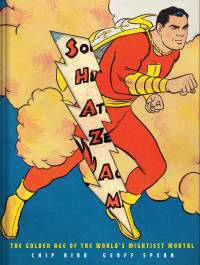 Home > CR Reviews
Home > CR Reviews Shazam! The Golden Age Of The World’s Mightiest Mortal
posted December 15, 2010
Shazam! The Golden Age Of The World’s Mightiest Mortal
posted December 15, 2010

 Creators:
Creators: Chip Kidd, Geoff Spear
Publishing Information: Abrams ComicArts, hardcover, 246 pages, December 2010, $35
Ordering Numbers: 0810995964 (ISBN10), 9780810995963 (ISBN13)
You can't blame Abrams for false advertising with this one. The latest exploration of superhero art, iconography, and design from Chip Kidd and Geoff Spear tells you right smack in the subtitle -- "The Golden Age Of The World's Mightiest Mortal" -- that top-five all-time costumed adventurer Captain Marvel will be examined, dissected and explored at the height of his popularity and from that perspective alone. That means a related, same-age Fawcett effort such as Spy-Smasher is going to be more important to what Kidd and Spear are trying to accomplish than the Big Red Cheese himself in his Schaffenberger, Ross, Ordway, or Smith incarnations. The Kidd/Spear approach doesn't irk me as it seems to occasionally grate on some hardcore comics people. There are dozens of ways to perceive of comics and their content; placing them within a design continuity alongside all of the ephemera and related merchandise that they spawn seems like a legitimate avenue of exploration. In fact, it's historically instructive. One can argue, for example, that in certain phases of some comics' development the way the art is expressed to fans through licensing efforts is more artistically important than the comics themselves. Did more eventual Marvel fans read the John Romita Sr.-drawn
Spider-Man comic books or see the John Romita Sr.-designed Spider-Man Macy's balloon? Do more future comic book buyers have as their first memory of loving Batman the time Frank Miller re-imagined him or the day they wore a certain Halloween costume? It's not where my heart lies, but I understand the line of inquiry.
Shazam!'s biggest strength is its documentary-style gathering into one place the junk-driven flowering of Captain Marvel-mania at its most potent, and how well those works suggest the sustaining joys of the original comic books as a month to month experience so potent kids were sent scrambling for approximations.
While a reader's basic generosity should allow the comics portions of these books to share the stage with other material, that doesn't mean the treatment of those comics needs to be limited in nature. I think that's a relevant criticism of
Shazam!: the approach to the comics themselves lacks inspiration and ultimately fails to cohere into its own idiosyncratic take. As suggested above, a variation of this criticism gets lobbed at all of the Kidd/Spear books, but I think there exists a noticeable discrepancy between how previous volumes manage to capture a hidden element of the art and the way
Shazam! hardly touches on even the more obvious ones. I can't imagine anyone making Captain Marvel comics now looking at an element of this material for specific inspiration, the way Grant Morrison recently picked up on a piece or two of the Jiro Kuwata Batman comics, for instance, or the way the
Peanuts book lay significant groundwork for a greater appreciation what Schulz can offer an adult reader. The Kidd/Spear approach has such a reliable, familiar strength that it's only when you take a step back and mull over the wealth of potential riches here -- three major superheroes, each superhero arguably a greater iconic realization of that beloved genre than the previous one; two all-time mainstream cartoonists (CC Beck, Mac Raboy); the opportunity to draw a strong distinction between this character and superhero-prime Superman -- that a measure of disappointment may set in. That there are hints of a more considered take frustrates further. When one reads observations about, say, Freddie Freeman's outright Dickensian existence and how that may run counter to the wish-fulfillment model of the Marvel family, or about the contrast between the way eyes are depicted by Beck and Raboy, one is grateful for the notes but also greedy for more. It's difficult to suppress one's appetite for dozens of such theories derived from different angles, contexts and comparison points, or at least two or three that sting, that send you back to the comics themselves with a changed perspective. Instead, even with what material is there, one is too often told of visual differences and conceptual strengths without actually seeing them displayed. I'll return to
Shazam! dozens of time, I'm sure -- but to look at it, not to learn from it. This is a minor book in a mighty constellation.


